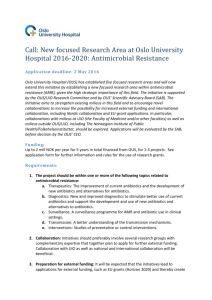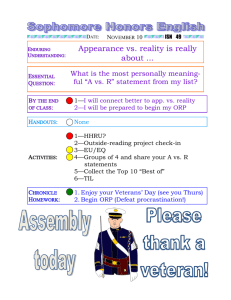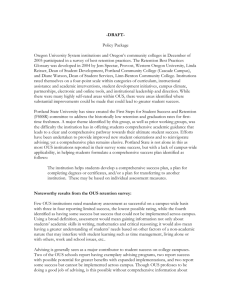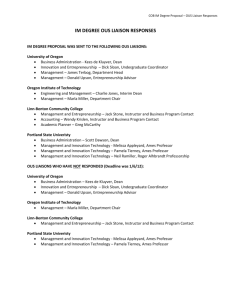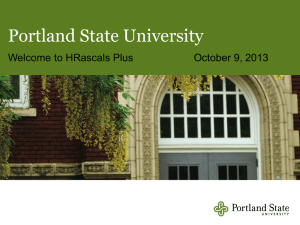Oregon University System Labor
advertisement
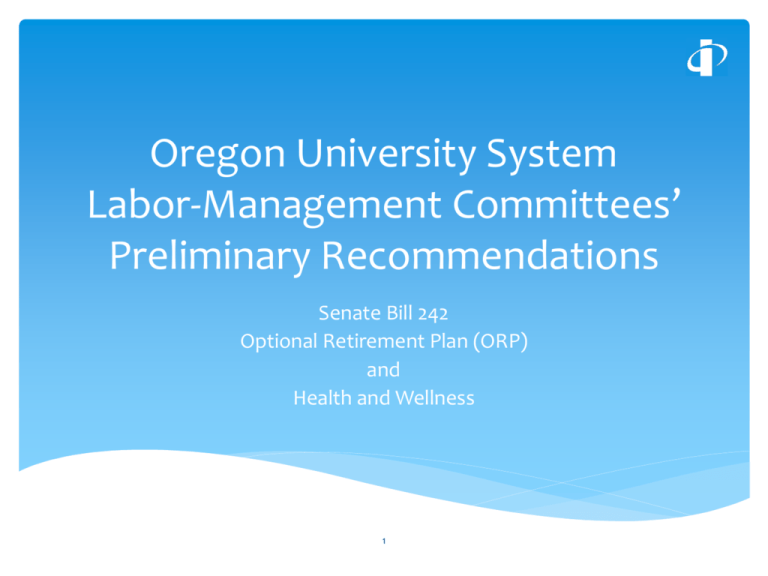
Oregon University System Labor-Management Committees’ Preliminary Recommendations Senate Bill 242 Optional Retirement Plan (ORP) and Health and Wellness 1 SB 242 Requirements Senate Bill 242 SECTION 1. Section 43, chapter 637, Oregon Laws 2011, is amended to read: Sec. 43. (1) The State Board of Higher Education shall establish a committee consisting of representatives of public university management and of employees, both represented and unrepresented, to evaluate options for: (a) An optional retirement plan as described in ORS 243.800; and (b) Continued participation in the Public Employees’ Benefit Board, transfer of employee participation to the Oregon Educators Benefit Board or participation in other, alternative group health and welfare insurance benefit plans. (2) The State Board of Higher Education shall make a report based upon the recommendations of the committee to the Legislative Assembly prior to [October] December 1, 2012. The State Board of Higher Education may not make any changes to retirement plans based on the report until July 1, 2013. The State Board of Higher Education must make any changes to group health and welfare insurance benefit plans between January 1, 2013, and May 1, 2013, to become effective on January 1, 2014. 2 Optional Retirement Plan (ORP) Committee Membership Committee members included: Scott Beaver, WOU Associate Professor John Chalmers, UO Associate Professor Larry Curtis, OSU Associate Dean Maude Hines, PSU Associate Professor Ron Narode, PSU Associate Professor Ernie Pressman, UO Benefits Administrator Shana Sechrist, PSU Associate Vice President of Human Resources Sandy Smith, WOU Budget and Personnel Manager Jay Stephens, SOU Director of Human Resources The committee was co-chaired by OUS Vice Chancellor Jay Kenton and OUS Retirement Plans Administrator Nathan Klinkhammer. 3 Optional Retirement Plan (ORP) Data Collection and Analysis: Survey of the entire population of active ORP participants (3,600) 1,600 responses were received (45% response rate) Currently ORS 243.800 links the ORP which is a defined contribution plan to PERS which is a hybrid plan (primarily a defined benefit plan and secondarily a defined contribution plan -aka IAP). Problematic for determining continuing eligibility; and Fluctuating rates make planning more difficult. IRS is requiring OUS to have a definitively determinable contribution rate in the ORP 4 ORP Committee Preliminary Recommendations Amend ORS 243.800 as follows to: Remove the restriction of the number of providers of annuity and mutual fund investment products to achieve preferential investment product pricing and to reduce administration costs. Restate eligibility requirements to improve operability with requirement to contribute monthly into daily valued, participantdirected investments. Establish a new defined contribution tier for eligible academic and administrative employees hired on or after July 1, 2014. Retain the current contribution, benefits and privileges of Tier One, Tier Two and Tier Three ORP Participants under ORS 243.800. New contribution model (for those hired after July 2014) may include match of 403(b) deferrals and full employer contributions to provide total Optional Retirement Plan contributions of 12%. 5 Health and Wellness Committee Membership Committee members included: Craig Morris, SOU Vice President for Finance & Administration David Hansen, PSU AAUP Faculty Donna Chastain, OSU Employee Benefits Manager Ernie Pressman, UO Benefits Administrator Grant Kirby, OIT Associate Professor Jim Terborg, UO Professor Kerry Gilbreth, PSU Associate Director of Benefits Marc Nisenfeld, PSU Science Support Center Marshall Guthrie, WOU Education Advisor-Student Enrichment Program Michael Lambrecht, EOU Human Resources Director Peter Callero, WOU Professor and PEBB Board Member Phil Lesch, PSU AAUP Executive Director Phillip Histand, MD, OSU Director of Student Health Services Robert Fullmer, PSU IT Specialist The committee was co-chaired by OUS Vice Chancellor for Finance and Administration Jay Kenton and OUS Chief Human Resources Officer Denise Yunker. 6 Health and Wellness Committee The committee engaged Gallagher Benefit Services, Inc. as consultants. Working with the consultants the committee: Worked through a comprehensive overview of group health insurance plan design and benchmarking; Learned about the history and status of PEBB, OEBB, and OUS’ affiliate Oregon Health Sciences University plan; Reviewed Oregon statutory requirements and mandates regarding health insurance; general health insurance concepts and types of plans; Discussed national health care reform issues; and administration and funding options for health and welfare plans. Commissioned an employee benefits survey to explore employees’ satisfaction with PEBB and opportunities to improve upon current plans and services. (entire population of 13,498 employees surveyed with a 5,666 responses - 42% response rate) Heard from Sean Kolmer, Governor Kitzhaber’s Healthcare Advisor and new chair of the PEBB Board 7 OUS Benefits Philosophy Statement These nine elements represent values that reflect the campus community’s needs and the committee’s goals for plans and services uniquely suited to a wide spectrum of employee demographic, employment, educational and socio-economic profiles that exist within the university system. Employee choice among high quality, affordable plans. Benefits are a part of total employee compensation that supports retention and recruitment. Plans and providers are available to employees and retirees in local provider network areas and in rural, national, and international locales where they are needed. Plans encourage and support members with a variety of programs and services to manage their own health by pursuing healthy lifestyles, and making healthy choices. Employees are included in decision-making about health and welfare benefit plans. Provider and plan reporting identifies and reports on areas of measurable progress and needs in health improvement. Clear, concise, accessible benefits information and member services tailored to the needs of university system employees. Cost containment as a balance between plan design and cost is a strategic goal. Member and plan services are timely, accurate, and responsive to the university system employees 8 and administrators. Key Findings Most survey respondents indicated general satisfaction with benefit programs, though concerns were expressed regarding: Service issues for employees working out of state/country and for rural universities Communications concerns, especially related to HEM and the manner in which other program changes were implemented 70% of employees expressed a desire to evaluate options other than PEBB; 12% favored staying in PEBB and 18% wanted to wait until the impacts of healthcare reforms became more clear Gallagher found that OUS paid PEBB $67M more than its claims cost during the 2010 and 2011 plan years and that if OUS switched to OEBB this would add another $29M to this two-year subsidy Increasing healthcare costs was acknowledged as a key driver of tuition 9 Gov. Kitzhaber’s Health Care Reforms Changing the way care in organized and delivered, via: Establishment of health insurance exchanges and Coordinated Care Organizations (CCO’s) Participants engaged in health management (HEM) Based on even larger healthcare pools, containing upwards of 1.0 million citizens Putting pressure on the provider networks to bend the cost curve Triple aim: better health, better care and lower costs. 10 Health and Welfare Committee’s Conclusions Although committee members’ perspectives varied on some specific health insurance issues, they agreed: The option of transferring to OEBB was not viable due to an actuarially estimated increase in cost to OUS; disruption of participant-provider relationships; significant differences in plan year and enrollment calendars; and questions about OEBB’s future direction. That there is interest in changing OUS’ participation in PEBB, but not complete agreement to separate from PEBB at this time; If the university system is unable to separate from PEBB, OUS’ representation in decision-making needs to be strengthened at the Board and operations levels; A benefits contribution structure based on actuarially determined price tiers or converted to single defined contribution amount would not be endorsed by all members; OUS’ long-standing subsidization of the insurance pool should be reduced based on OUS’ costs and contribution rates for better control of benefits costs that relate to student tuition for Oregonians; and Special needs such as adequacy of out-of-area coverage remain to be addressed for OUS employees. 11 Health and Welfare Committee’s Preliminary Recommendations Continuing with PEBB requires significant movement to act on the committee’s recommendation (shown below) giving the university system official standing and voice in PEBB’s operations and management through a chartered OUS benefits council or workgroup that would be charged with implementation of the committee’s specific recommendations for this report and ongoing redress of OUS’ issues: Establish an OUS Benefits Council /PEBB Workgroup to improve OUS input into PEBB and to improve the value for cost of continuing with PEBB, including: Replacing PEBB’s Health Engagement Model (HEM) with an alternative employee engagement model is a priority for OUS Contribution rates - OUS needs the ability to establish a unique composite rate based on it own employee costs Worldwide coverage Blanket approval is requested for OUS to contract for other health coverage under ORS 243.215 for rural, national and international coverage, with PEBB funding offsets sufficient to provide benefits equal to the cost of the current third party administrator’s out-of-area network providers. Improved enrollment and payment management systems Dedicated PEBB staff are needed to better serve OUS ii Practice and policy changes are desired, including: Pharmacy Flexible spending accounts Tele-Health Expansion Fitness Incentives Reducing OUS’ longstanding subsidization of the PEBB insurance pool 12 Next Steps: October – preliminary reports posted on OUS website Campus presentations Faculty Senate meeting Benefit Fairs Meetings with labor groups Board briefing – October 5 November Final committee meeting to consider input Final Board approval of Committee reports and cover letters containing Board’s comments and concerns – November 16 Final reports posted on OUS website December 1 – final reports submitted to Legislature 13 To review full reports, see: Optional Retirement Plan (ORP): http://www.ous.edu/sites/default/files/dept/hr/benefits/files/SB242_ORP_RecommendationDraftReport_092812.pdf Health and Wellness: http://www.ous.edu/sites/default/files/dept/hr/benefits/files/SB242-Health-WelfarePlansOptionsReport_092812.pdf Please send comments, if any by October 30, 2012 to your committee representative or to: ORP – SB242ORP@ous.edu H&W – SB242HealthPlans@ous.edu Thank you! 14
